Hanover Bald Egle Blog # 8 - 2022
In partnership with Pennsylvania Game Commission and Comcast Business .
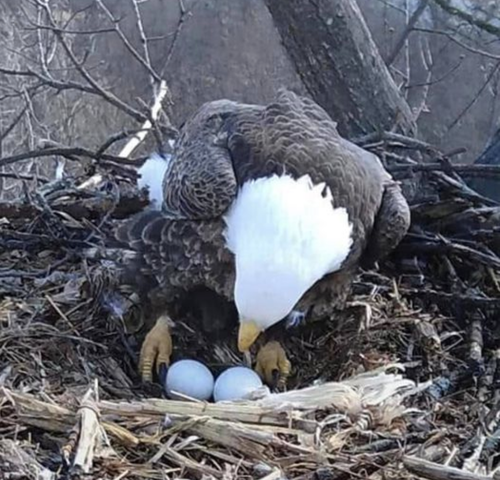
TODAY MARKS THE 16TH DAY SINCE EGG #1 WAS LAID, AND THE 13TH DAYS SINCE EGG #2 WAS LAID.
BOTH EMBRYOS NOW HAVE PARTIALLY FORMED EYES, BEAKS, TONGUES, AND EGG TOOTHS. THEY ALSO HAVE WING, TAIL, AND LEG BUDS!
Check out the above video if you missed the Hanover Eagle's laying of the second egg!
Since the 1870s, people who study eggs, called oologists, have puzzled over the coloring of bird eggs. Why are some eggs white and some speckled? Why are peregrine falcon eggs red? Why are robin eggs blue?
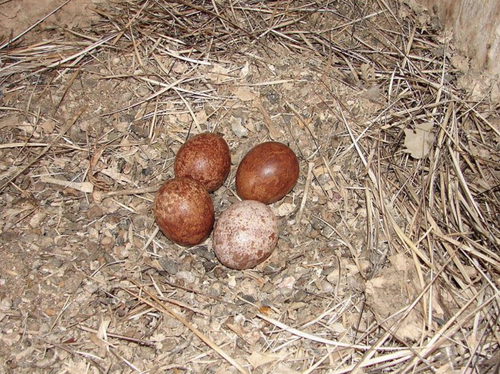
Peregrine falcon eggs. (Source: Wikimedia Commons).
Oologists used to think that the coloration of bird eggs was merely an accidental byproduct of the laying process. Later, they verified that eggs were painted with different pigments as they moved through the female’s oviduct. However, this only addressed how eggs were colored, not why.
Bird eggshells are made of calcium carbonate, which is naturally white. Producing pigments is energetically taxing for the female, which means the rewards of producing a colored egg must be worth it. But why?
Most ornithologists and oologists agree that egg coloring is related to the threat of predation. Well-camouflaged eggs are less likely to be eaten. Take the kildeer, a medium-sized member of the plover family, which usually lays its eggs directly on gravel, with nothing more than a small indentation in the ground holding the clutch in place. These eggs, though exposed, blend into their environment remarkably well. Kildeer parents also perform a “broken-wing display” during which they feign injury in order to lure approaching predators away from the nest. Genuis!
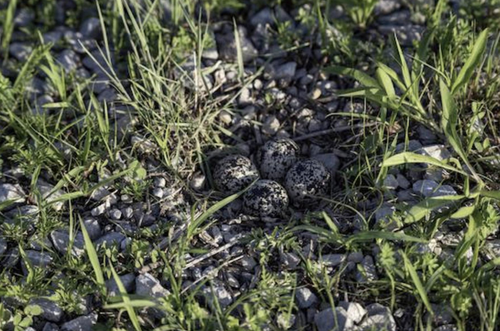
Killdeer Eggs. (Source: Rick Cameron).
Other birds have vibrantly colored eggs that scream out for attention. How can a robin afford to lay such noticeably blue eggs?
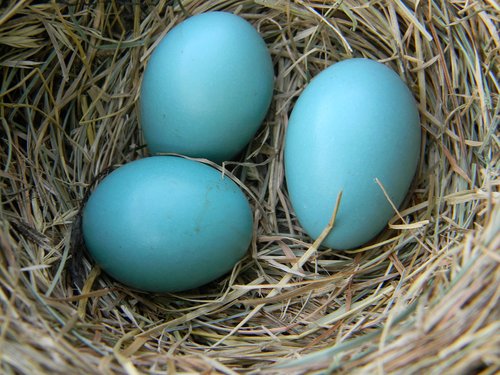
Robin Eggs. (Source: Laslo Varga).
One hypothesis is that laying noticeably colored eggs helps incubating parents spot intruder eggs in their nest, thereby avoiding the downsides of nest parasitism. This is when one species, like brown-headed cowbirds, lay their eggs in the nest of another species to avoid raising their own offspring (rude, but ingenious). Robins are known as “rejectors,” meaning they quickly dispose of intruder eggs. This could be because in a clutch of bright blue eggs, an imposter egg is easy to recognize.
Video of a Robin rejecting cowbird egg.
Another possible explanation is that blue eggshells have been shown to absorb more light than other colored eggshells, and therefore may aid in speeding up the process of embryonic development.
There is also some evidence that male robins are more attentive to chicks that hatch from bluer eggs. The pigment that makes eggs blue is called biliverdin, and females can produce more biliverdin when they are in good body condition. In this study, researchers found that male robins were more attentive to chicks that hatched from the bluest eggs.
Some species, like the common murre, lay clutches with incredible color variation between individual eggs. Murres are colonial nesters. Thousands of birds nest shoulder to shoulder on island or sea cliff breeding grounds. By laying uniquely patterned eggs, it’s thought that parents may more easily identify their own eggs and avoid accidently plopping down on a neighbor’s nest instead of their own. Which would be hawkward.
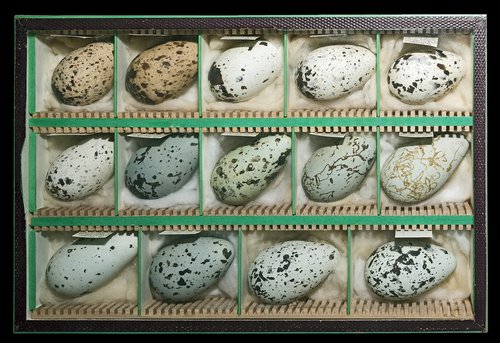
A sampling of pigment variation in common murre eggs. (Source: Creative Commons).
So how do all of these examples relate to the Hanover eagle pair? Let’s ask ourselves, which of the concerns mentioned above would be most relevant for a pair of bald eagles?
- Predation
- Brood parasitism
- Identification of their own eggs
You guessed it — none of them! Of course, predators are of some concern, but due to the extreme height of most eagle nests, the aggressive behavior of eagle parents, their large size, and their constant presence during incubation, the chance of a predator snatching eagle eggs is significantly lower than for many other bird species. Furthermore, eagles begin incubating as soon as the first egg is laid, and the nest is high enough that few predators could locate the eggs using sight alone.
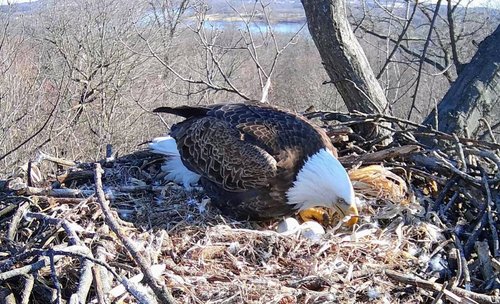
Bald eagles do not need to worry about identifying their own eggs over those of their non-existent neighbors, and brood parasitism is not very common in raptors — I, for one, would choose many other host parents before attempting to trick a bald eagle.
So, with all this in mind, the fact that bald eagles lay white eggs makes good sense. Some researchers theorize that white eggs are better at dispelling solar radiation which protects the embryo from overheating, but this has not yet been proven for bald eagle eggs.
The scientific community still has much to learn about bird eggs, and raptor eggs are particularly mysterious due to the secretive tendencies of adults and the difficulty of safely investigating nests. Most of what we know about bird eggs comes from poultry studies, colonial seabird research, and analysis of museum specimens.
What we can surmise is that bald eagle eggs are white for a reason, and that so far, their simple color scheme seems to be working well.
QUIZ QUESTION: CAN YOU PUZZLE OUT WHY PEREGRINE FALCON EGGS ARE RED? THEY ARE RAPTORS, JUST LIKE BALD EAGLES. WHAT’S GOING ON?
LAST WEEK’S ANSWER: ALASKA HAS THE LARGEST POPULATION OF BALD EAGLES IN THE UNITED STATES.
Sources
Birkhead, Tim (2017). The Most Perfect Thing. London. Bloomsbury Publishing PLC.
Harris, Arthur H. Biology/Amniotes and Anamniotes. Desert Diary. http://museum2.utep.edu/archive/biology/DDamniotes.htm
Raptor Resource Project. (2021, March 3). Peek inside a bald eagle egg: 11 days!
https://www.raptorresource.org/2021/03/03/peek-inside-a-bald-eagle-egg-11-days/
Sharpe, Peter. Guide to Bald Eagle Egg Incubation and Chick-Rearing. Institute for Wildlife Studies. https://www.iws.org/Incubation%20Manual.PDF
Queen’s University. (2012). Color of robins’ eggs determines parental care. Science Daily. www.sciencedaily.com/releases/2012/05/120514122838.htm

RETURN TO HANOVER BALD EAGLE BLOGS
WATCH THE HANOVER BALD EAGLE LIVE CAMS
For over 20 years, HDOnTap has provided live streaming solutions to resorts, amusement parks, wildlife refuges and more. In addition to maintaining a network of over 400 live webcams, HDOnTap specializes in design and installation of remote, off-grid and otherwise challenging live streaming solutions. Contact press@hdontap.com for all media needs, including images and recordings.

